|
. Here is the entry for Quagliata found in the Heraldic Archives of Vallardi on page 229:
|
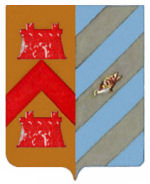 .
.
Thanks to the research of Professor Iana
Quagliata, we know that the Heraldic Archives of Vallardi has a record
of a Quagliata Coat of Arms, a small image of which
is shown on the right. The Quagliata Coat of Arms recorded by
Vallardi displays four
colors: The principle metal is gold and the principal color is red, both
displayed in the primary (left from your view) field. The secondary
(right from your view) field displays the metal
silver and the color blue. The description of a coat of arms is known as a
blazon.
|
 . . |
|
Vittorio Quagliata noted: The left part of the shield is the most
ancient; it sports two Ghibellini’s castles, meaning that the family is
an old one, a member of the Ghibellini Party that opposed the Pope in
central and northern Italy in the thirteenth century. The right half of
the shield is a most recent addition, the bird in the silver stripe is a
quail (meaning reflection and truth). . This information came to light during Professor Quagliata's research on Giovan Battista Quagliata (1603-1673). Her research shows Giovan enjoyed the patronage and friendship of the Viceroy of Sicily, Don Juan José of Austria - Viceroy of Sicily from 1649 to 1651. Viceroy José was also a student of Giovan's. It was not unusual for a favored artist to receive the honor of nobility from their politically connected patrons. Viceroy Don Juan José granted Giovan Battista Quagliata a noble title with a coat of arms and some land in the countryside area of Forza D'Agro, Sicily, between the city and the sea, where the new city of Sant’Alessio Siculo later developed, and from where most of his descendants come. However, our study of all the available evidence and information indicates it's possible that the Quagliata Coat of Arms originated earlier than the mid 1600s, possibly in 13th or 14th centuries. |
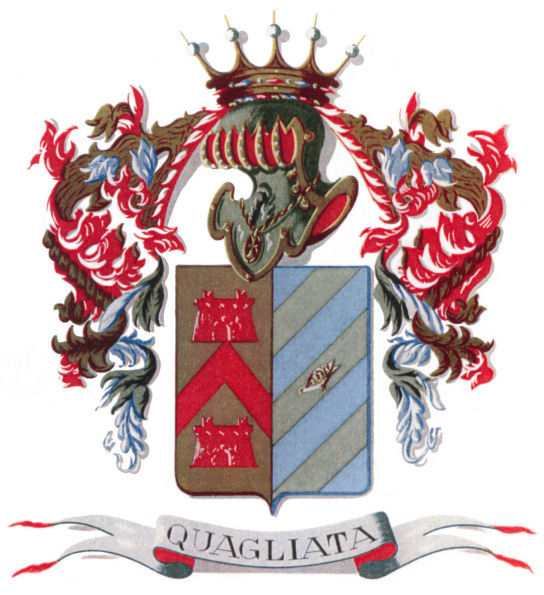
| The rendering shown above was done by the Guelfi Camajani Studio of Heraldry in Genoa, Italy. Our independent source for the blazon (description of the arms) is the Heraldic Archives of Vallardi, page 229. According to our own historical study, and the study of the Guelfi Studio, these arms belonged to Giovan Battista Quagliata (1603-1673). Therefore we believe the coat of arms of Giovan Battista Quagliata displayed above to be authentic and rendered properly, according to the correct blazon. To claim or use the Quagliata Coat of Arms, you must be able to demonstrate patrilineal descent from the original holder of the arms. Based on our own genealogical studies and those of the Guelfi Studio, we can say with a reasonable amount of certainty that the Quagliata families whose lines trace back to the Sicilian towns of Forza D'Agro and/or Sant'Alessio Sicculo are descended from Giovan Battista Quagliata. However, despite the results of the Guelfi Studio study, our own studies were unable to fully document a direct link the earliest traceable births (1780s) in these lines back to Giovan Battista Quagliata who, in fact, while living, had owned the lands these births occurred on. |
|
. |
 The
indications that the Quagliata Coat of Arms originated in a time earlier
than 1650 can be found in its blazon (heraldic description), in the passage that contains the words:
"...a castle with two of the same Ghibelline merlons...". In medieval times, castle battlements,
sitting on top castle walls and towers, were made of
merlons ending in a normal
square or rectangular shape. However, there was a
notable European variant called a Ghibelline merlon that ended in a
swallow tail shape, conversely the normally shaped battlement was referred
to as a Guelph merlon. These shapes can be seen in the images on
the right. The
indications that the Quagliata Coat of Arms originated in a time earlier
than 1650 can be found in its blazon (heraldic description), in the passage that contains the words:
"...a castle with two of the same Ghibelline merlons...". In medieval times, castle battlements,
sitting on top castle walls and towers, were made of
merlons ending in a normal
square or rectangular shape. However, there was a
notable European variant called a Ghibelline merlon that ended in a
swallow tail shape, conversely the normally shaped battlement was referred
to as a Guelph merlon. These shapes can be seen in the images on
the right.Beyond their connection to the design of castle battlements, the words Ghibelline and Guelph had additional meaning having to do with the Investiture Controversy in the 11th century, particularly in Italy. The Investiture Controversy was a dispute over who controlled appointments of church officials (investiture) - the Holy Roman Emperor or the Pope. The conflict was brought about in 1075 when the Holy Roman Emperor, Henry IV, installed his chaplain as Bishop of Milan, when a candidate had already been chosen in Rome. In 1076, Pope Gregory VII responded by excommunicating the king, removing him from the Church and deposing him as German king. The word "Ghibelline" dates to the House of Hohenstaufen (1138-1254), a noble German family whose members included rulers of the Holy Roman Empire and kings of Germany and Sicily. The use of the word "Ghibelline' came about during the Battle of Weinsberg in 1140 (part of a civil war in Germany), which occurred in southern Germany and pitted the Bavarian dukes of the Welf family (Welf in Italian became: Guelph, often spelled Guelf), against the Hohenstaufens of Swabia. The Hohenstaufens used the word 'Waiblingen', the name of a castle, as their battle cry. Waiblingen, at the time pronounced and spelled somewhat like "Wibellingen" (Wibellingen in Italian became: Ghibelline). The words "Ghibelline" and "Guelph" were likely introduced to Italy during the reign of Frederick Barbarossa of the House of Hohenstaufen, who was crowned Holy Roman Emperor by Pope Adrian IV on 18 June 1155. When Frederick campaigned in Italy to expand imperial power there, his supporters became known as "Ghibellines" (Ghibellini). It was during this time period in Italy, the division between the two distinct "Ghibelline" and "Guelph" parties became defined as we know it today: the Ghibellines were the imperial party supporting the emperor, while the Guelphs were the Church party supporting the Pope. In Italy, from 1155 into the 1300s, the medieval age was a time of unending conflicts and battles for Ghibellines, Guelphs, Italians, Frenchmen and Spanish, as most of southern Europe was involved in these disputes. The majority of the battlefields in the Italian conflicts were located in the northern regions of Liguria, Tuscany, Lombardy, and Veneto, as well as the north-central regions of Emilia-Romagna, Umbria and Marche. The balance of power swung back and forth between the two parties many times. By the 1400s the conflicts between the Ghibellines and Guelphs began to wane and eventually Emperor Charles V firmly established imperial power in Italy in 1529. |
|
|
. The Origin of the Quagliata Coat of Arms - . |
| In her booklet, "Giambattista Quagliata, Painter and Architect of the 1600s", Professor Quagliata doesn't give a date or name as to when or to whom the Quagliata Coat of Arms was originally awarded, but definitely hints at an earlier origin of the arms: "Giambattista 'obtained from the Viceroy many honors'...a noble title...but, the coat of arms seems to attest to a more ancient nobility." Giambattista Quagliata (aka Giovan Battista Quagliata) was born in 1603, well after the Ghibellines and Guelphs engaged in conflicts and battles, yet the permission to display a castle on a coat of arms was usually granted to one who had faithfully held a castle for his sovereign, or who had captured one by force or strategy. In this case a chevron (symbolizing protection) is grouped with two Ghibelline castles, indicating that the holder was most likely an important military leader who protected a castle or multiple castles from attack. Therefore, there can be no doubt that the Quagliata awarded a coat of arms displaying two Ghibelline castles lived in an earlier time period then the 1600s and performed military services to a sovereign associated with the Ghibellines - most likely in the 13th or 14th centuries. Furthermore, since most of the battles took place in central and northern Italy, the Quagliata awarded this coat of arms must have served somewhere in those areas, but still could have lived in central or southern Italy. |
 Professor Quagliata quotes the 18th century author Francesco Susinno: "[Giambattista]
...obtained from the Viceroy many honors..." We know Viceroy Don Juan José
granted Giambattista a title and lands. And, we should note that on the inner
sleeve of Professor Quagliata's booklet is an introduction by Alexandre Kessler who
writes: "[Giambattista Quagliata] A man of noble origins, decided to study in
Rome, City of the Arts and also the cradle of his family." Kessler's use of
the word "noble" indicates
that Gaimbattista's father, who had moved from Rome to Messina, may have
already possessed/inherited the Quagliata Coat of Arms. Since the Quagliata shield
associated with Giambattista
is divided, it's possible that a previous family member, living in the area of
Rome, had been granted a coat of arms in the 1200s or 1300s
for service to the Ghibellines. This original shield may have looked something like the one
shown on the upper right - note its militaristic charges (objects
- castles) and ordinary (geometric figure -
chevron) and
use of the color
red (warrior or martyr; military
strength and magnanimity).
When Giambattista was granted his own coat of arms, his shield probably looked something
like the one shown on the lower right - note the peaceful symbology (silver (peace and
sincerity), blue
(truth and
loyalty), quail (peace and affection
of home and family; reflection and truth)). The rules of heraldry allow the holder of multiple arms to
put them together in a display on one shield as shown on the left. In this scenario,
Giambattista would have inherited the earlier coat of arms and combined
it with his own,
displaying two arms
on his shield, which was divided in 'perpale' partitioning (vertically in half),
a division style that is considered to be the format of the Ghibelline
party. The
more important and/or older arms
are displayed in the primary partition (left, from your view), and the less important
and/or newer arms
are displayed in the secondary partition (right). This is exactly what we see
described in the Quagliata Blazon recorded on page 229 of the Heraldic
Archives of Vallardi. The scenario fits the known facts nicely:
The primary partition in gold, contains a militaristic grouping in the
color red associated with the Ghibellines, who were active in Italy between
1155 and 1529, which is the time period these arms were most likely granted.
The secondary partition is in blue (truth and
loyalty), with 3.silver
(peace and
sincerity) bars and a
quail (reflection and truth), all symbology that fits the
artist and architect Giambattista Quagliata, who received the honor from
Viceroy Don Juan José between 1649 and 1651.
While this scenario fits the facts very well, at this time we can not confirm
it. It is however, our best hypothesis on how the Quagliata Coat of Arms
originated. Professor Quagliata quotes the 18th century author Francesco Susinno: "[Giambattista]
...obtained from the Viceroy many honors..." We know Viceroy Don Juan José
granted Giambattista a title and lands. And, we should note that on the inner
sleeve of Professor Quagliata's booklet is an introduction by Alexandre Kessler who
writes: "[Giambattista Quagliata] A man of noble origins, decided to study in
Rome, City of the Arts and also the cradle of his family." Kessler's use of
the word "noble" indicates
that Gaimbattista's father, who had moved from Rome to Messina, may have
already possessed/inherited the Quagliata Coat of Arms. Since the Quagliata shield
associated with Giambattista
is divided, it's possible that a previous family member, living in the area of
Rome, had been granted a coat of arms in the 1200s or 1300s
for service to the Ghibellines. This original shield may have looked something like the one
shown on the upper right - note its militaristic charges (objects
- castles) and ordinary (geometric figure -
chevron) and
use of the color
red (warrior or martyr; military
strength and magnanimity).
When Giambattista was granted his own coat of arms, his shield probably looked something
like the one shown on the lower right - note the peaceful symbology (silver (peace and
sincerity), blue
(truth and
loyalty), quail (peace and affection
of home and family; reflection and truth)). The rules of heraldry allow the holder of multiple arms to
put them together in a display on one shield as shown on the left. In this scenario,
Giambattista would have inherited the earlier coat of arms and combined
it with his own,
displaying two arms
on his shield, which was divided in 'perpale' partitioning (vertically in half),
a division style that is considered to be the format of the Ghibelline
party. The
more important and/or older arms
are displayed in the primary partition (left, from your view), and the less important
and/or newer arms
are displayed in the secondary partition (right). This is exactly what we see
described in the Quagliata Blazon recorded on page 229 of the Heraldic
Archives of Vallardi. The scenario fits the known facts nicely:
The primary partition in gold, contains a militaristic grouping in the
color red associated with the Ghibellines, who were active in Italy between
1155 and 1529, which is the time period these arms were most likely granted.
The secondary partition is in blue (truth and
loyalty), with 3.silver
(peace and
sincerity) bars and a
quail (reflection and truth), all symbology that fits the
artist and architect Giambattista Quagliata, who received the honor from
Viceroy Don Juan José between 1649 and 1651.
While this scenario fits the facts very well, at this time we can not confirm
it. It is however, our best hypothesis on how the Quagliata Coat of Arms
originated. |
|
HERALDRY,
SYMBOLS
AND
RANK
.
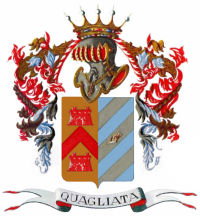 This section is by no means meant to be an exact
and complete treatment of Heraldry, but is here to provide those interested in
the topic with some basic information to help them understand the standards,
symbology and ranking conventions of Heraldry. This section will also
provide a more complete discussion of the heraldry, symbols and rank displayed
in the Quagliata Coat of Arms.
This section is by no means meant to be an exact
and complete treatment of Heraldry, but is here to provide those interested in
the topic with some basic information to help them understand the standards,
symbology and ranking conventions of Heraldry. This section will also
provide a more complete discussion of the heraldry, symbols and rank displayed
in the Quagliata Coat of Arms.
The beginnings of modern heraldic structure were in
place by 1066, but would not become standard until the middle of the 12th
century, around the time
of the Crusades. By this time, coats of arms were being inherited by the
children of armigers (persons entitled to use a coat of arms) across Europe. In battle, a knight dressed in armor from head to foot would be
barely recognized by friend or enemy, so a new method of identification became
necessary. This resulted in special markings being painted on the knight's
shield and on the coat he wore over his armor (Coat of Arms). This method
of identification was eventually employed by the aristocracy and nobility.
Between 1135 and 1155, seals show the general adoption of heraldic devices in
England, France, Germany, Spain, and Italy.
Heraldry has its own special language which describes the acceptable available
formats and symbols.
It should be noted that while noble titles and coats of arms are, in general,
heritable, a person claiming a coat of arms must have a proven
patrilineal pedigree going back to the original owner of the arms and the
approval of a proper sanctioning body in those places where such bodies have
jurisdiction.
In other words, just sharing the same surname as an historical figure who had a
title and arms does not give one the right to claim the title and arms.
Intentional fraud of this kind became especially frequent in the 1950s and
persists to this day, with some unscrupulous genealogical or heraldic research
firms attaching coats of arms to all the lineal genealogies they complete,
implying that every family that pays them is an aristocratic one. Some
countries which are no longer monarchies, like Italy, France and Russia, along
with many other countries, don't officially regulate Heraldry. In those
countries, such business practices may be legal, but are ethically questionable.
A few countries, like the United Kingdom, Spain, Ireland, South Africa and Canada,
regulate Heraldry, and in those places, such business practices would be considered
legally questionable and might even break the local law. In any case, it is
simply unethical and wrong for one to claim a coat of arms as their own without a proven
patrilineal pedigree. In the case of the Quagliata Coat of Arms, according
to our genealogical and historical research, we can say with a reasonable
amount of certainty that the Quagliata families who's lines trace back to the
Sicilian towns of Forza D'Agro
and/or Sant'Alessio Sicculo are descended from Giovan Battista
Quagliata. However, our studies lack the documentation to directly link the
earliest traceable births (1780s) in these lines back to Giovan Battista Quagliata who,
in fact, while living, had owned the
lands these births occurred on. So to
be clear, at this time, we can not prove, with proper documentation, a link between Giovan Battista Quagliata and any of the Quagliata lineages of which we are
currently aware.
The chart below shows the elements of a coat of arms. As mentioned above,
the blazon is the official description of a coat of arms. Renderings of
coats of arms are created by following the description contained in the blazon.
|
|
Below is a listing of the elements of a coat
of arms, including information on their display and meaning in the Quagliata
Coat of Arms.
| Crown - (or Coronet) is borne above the helmet and denotes the noble rank through its style and decoration. A crown is not a required element and although it may be displayed in the coat of arms, it is not part of the official blazon. A person entitled to wear a coronet customarily displays it in their coat of arms above the shield. Researching the crown found in the current rendering of the Quagliata Coat of Arms on the website "The Coin - Network of Coin Collecting and Stories", using their "Manual of Heraldic", we found the crown of an Italian 'Nobile' was a very good match for the crown shown on the Quagliata coat of arms. An Italian Nobile is equivalent to the English 'Baronet' (aka: Bart or Noble). It is a hereditary rank awarded by the sovereign and may not have an accompanying title. The number of pearls on the crown denote the noble rank: an Italian baron has 12 pearls (7 visible), while the Nobile has 8 pearls (5 visible) and the Knight (Cavaliere) has 4 pears (3 visible). The pearls may sit on the rim of the crown or be supported by points. A definition of an Italian Nobile includes the terms: 'landed gentry'. That exactly fits what we know of Giovan Quagliata - he was awarded a noble title and lands and the crown associated with his coat of arms displays 5 visible pearls. The Quagliata crown also displays the Coat's colors as red and blue inlaid jewels separated by gold knobs. |

|
| Wreath - a roll or chaplet above the helmet, supporting the crown or crest and an optional element, not part of the official blazon. The wreath is also known as a Torse. It is supposed to represent a twist of two silken cords, one tinctured like the principal metal, the other like the principal color, in the arms. The current rendering of the Quagliata Coat of Arms shows a wreath between the crown and helmet. In this case it is a twist of four silken cords using the principal metal and color - gold and red, as well as silver and blue. From left to right, the visible twists begin with gold, then silver, blue, red - then repeating gold, silver, blue, red - then ending on the right with a gold twist. An interesting and unusual arrangement for a wreath. |
 |
| Helmet - is borne above the shield and beneath the crest, but is not part of the official blazon. On the right is an illustration that depicts some heraldic Italian helmets - the one on the far right is an extremely close match of the Quagliata helmet (click for a larger view), and the style is generally referred to as 'peer'. Initially it is believed that the helmet was used to denote the rank of the wearer based on: the metal - gold, silver, polished steel; the position - facing straight on, in profile or partial profile facing to the right or left; the angle of opening of the visor and/or the number of visor grills or grates. A silver helmet bordered in gold, lined in crimson, with a visor of 6 or 9 grates of gold denoted a Nobile. However, more recently, it has been left within the discretion of the artist which helmet is used. A helmet for a noble was typically displayed as a silver helmet in ¾ side view customarily placed above the shield. If the noble was entitled to wear a coronet, it was displayed surmounting the helmet above the shield. This is the format we find in the Quagliata coat of arms, along with the optional addition of a wreath. |
 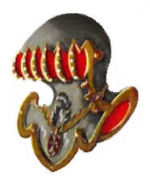 |
|
Shield - actually, there is more than one word which refers to
the shield, the primary ones being shield or escutcheon, which refer to the
physical form itself. There is some debate as to the meaning of the shape
of the shield, but most historians agree that the shape was usually
determined by the time period and geographic region. The shape is not a
part of the official blazon, so the shape of the shield and the angle at
which it is displayed are the artists choice. Next is the term "Field", which refers to the surface
of the shield, or if the surface is sectioned by being halved or quartered it
refers to each section separately.
The Quagliata shield is divided in two equal parts with a vertical line running
from the top to the bottom point. This is known as 'perpale' partitioning. This is an ancient division style and is
considered to be the format of the
Ghibelline
party (aka Imperial party) - they supported the rule of Holy Roman Empire in
central and northern Italy during the 12th and 13th centuries, opposing the
Papacy and the Guelph or Church party. . Shield Elements - are part of the official blazon. There are many terms which refer to the elements and designs on the face of the shield itself, including: Tinctures - the metals, colors, and furs on the shield. The primary metal of the Quagliata Coat of arms is gold (regality, majesty, generosity and elevation of the mind); silver (peace and sincerity) is also used in the bars of the second field. The primary color is red (warrior or martyr; military strength and magnanimity) and blue (truth and loyalty) is used in the second field. Ordinaries - these are the most basic patterns utilized on the face of the shield or fields to break it into sections. The left field of the Quagliata shield is sectioned by a red chevron. The chevron represents the roof of a house and is from the French word 'chevron' meaning rafter. In heraldry, the chevron (or bracket) is one of the nine honorable ordinaries and stands for protection. Charges - are the objects displayed on the surface, or field, of the shield which makes it truly unique for each individual Coat of Arms. Charges can be animal, plant or physical objects. The left field of the Quagliata shield has two charges, both Ghibelline castles. Castles are normally shown as two towers with a wall between them, the wall having a gate, which is the case here, except the battlements (merlons) display the Ghibelline "swallowtail" configuration. The castle symbolizes spiritual power and vigilance on the watch as well as home and safety. The castle was often granted to one who has faithfully held a castle for his sovereign, or who has captured one by force or stratagem. Since a castle is displayed both above and below the chevron, the group apparently portrays a warrior who protected a castle or multiple castles from attack. The second field of the Quagliata shield contains a Quail. Birds (ie: blackbird, bluebird, red bird; not birds of prey) represent the peace and affection of home and family. The Quail in particular represents reflection and truth. |
|
| Mantle - (also known as Mantling) is believed to represent the fabric used to protect the helmet from the elements and heat of the sun. It became more decorative and was usually shown in the principal colors (usually primary metal and primary color) of the shield, however in some grants of arms the colors are actually specified. Typically, the color of the inside of the Mantle is the primary shield metal and the color of the outside is the primary shield color. There are many ways of displaying the mantling, from the simplest to the really complex and there is no set rules as to exactly how they should be drawn and the mantle is not part of the official blazon. The Quagliata mantle is currently rendered as a complex flourish of cords and plant designs. The typical arrangement is used (primary metal on the inside and primary color on the outside), with the secondary metal and color used for additional complexity. |
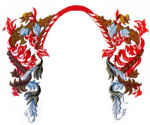 |
| Many thanks to Professor Iana Quagliata, originally from Forza D'Agro and currently residing in Monza, Italy, who researched Giovan Battista Quagliata and contributed her work to our project. Also, thanks go to our long time contributor Vittorio Quagliata of Milan for his efforts in acquiring this information for our project. And finally, thanks to Angie Atkin - Angie emailed looking for help with the coat of arms associated with her family, the Cuccomarino. Angie and I exchanged several emails and ended up helping each other in research. |